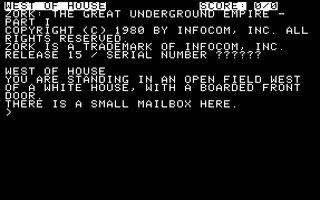

| CS 422 |
User Interface Design | Focus on developing effective
user
interfaces |
Every spring |
| CS 426 |
Video Game Programming | Focus on creating complete audio visual interactive (and fun) experiences | Every fall |
| CS 488 |
Computer Graphics I | Focus on the basics of how computers create images on screens, OpenGL | Every fall |
| CS 522 |
Human Computer Interaction | Focus on interaction and evaluation of interactive environments | |
| CS 523 |
Multi-Media Systems | Focus on the creation of Educational Worlds | |
| CS 525 |
GPU Programming | Focus on shaders and parallel processing | Spring even years |
| CS 526 |
Computer Graphics II | Focus on Scientific Visualization |
Spring odd years |
| CS 527 |
Computer Animation | Focus on creating realistic motion | Fall even years |
| CS 528 |
Virtual Reality | Focus on immersion | Fall odd years |
'Virtual Reality' is a nice buzzword that can mean a lot of different things depending on who you talk to.
The key element to virtual reality is immersion ... the sense of being surrounded.
A good novel is immersive without any fancy graphics or audio hardware. You 'see' and 'hear' and 'touch' and 'taste' and 'smell'
A good play or a film or an opera can be immersive using only sight and sound.
But they aren't interactive which is another key element.
Older
textual computer games from the late 70s and early 80s such as
Adventure, Zork, and the Scott Adams (not the Dilbert guy)
adventures are immersive and interactive and
place the user within a computer generated world, though that
world
was created only through text. You can play adventure online at
http://www.astrodragon.com/zplet/advent.html. You can play zork online
at
http://thcnet.net/zork/index.php or http://www.xs4all.nl/~pot/infocom/
or at several other sites. The Scott Adams adventures are playable at
http://www.freearcade.com/Zplet.jav/Scottadams.html


Games
in the early 80s started to incorporate primitive graphics to go along
with the
text, such as Mystery House below.

and even simple 1st person graphics in games such as Akalaberth and Wizardry below, though the screen refresh rate was something less than real-time. The screen took a long time (up to several seconds) to re-draw so these games tended to be more strategy-based on a turn-taking model.
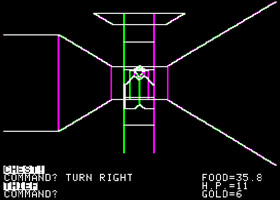
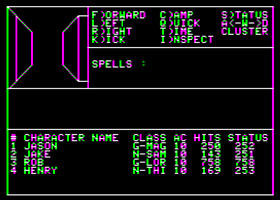
If we move towards modern computer games, they are immersive and interactive. These also have the advantage of being real-time running at 30 to 60 frames per second, another key element.
Another key element of VR is a viewer centered perspective where you 'see' through your own eyes as you move through a computer generated space, interact with objects there, and more often than not kill everyone you meet. The way you see the environment is limited to a screen with a narrow angle of view and you use a keyboard / joystick / gamepad to change your view of that scene.
VR adds the concepts of head tracking, wide field of view and stereo vision
Head tracking allows the user to look around the computer generated world by naturatlly moving his/her head. A wide field of view allows the computer generated world to fill the user's vision. Stereo vision gives extra cues to depth when objects in the computer generated world are within a few feet.
As Dan Sandin likes to say, this gives us the first re-definition of perspective since the Renaissance (16th century)

Albrecht Dürer, Daraughsman Drawing a Recumbent Woman (1525) Woodcut illusion from 'The Teaching of Measurements.'
Audio also plays a very important role in immersion (try listening to a modern hollywood film without its musical score) and haptic (touch) feedback can provide important cues while in smaller immersive spaces.
And there is some work in trying to deal with smell (the HITLab in the late 90s, and Yasuyuki Yanagi, Advanced Telecommunications Research Institute, Kyoto more recently) and taste (Hiroo Iwata, University of Tsukuba.)
So here is a picture that puts a lot of this together ... Randy Smith of General Motors in their CAVE. Randy is real. The car seat Randy is sitting in is real. The rest is computer generated.
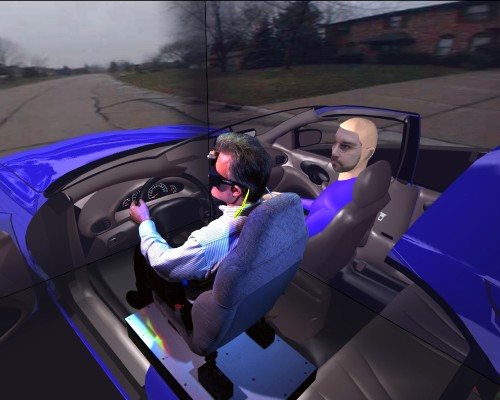


For projection based systems, some companies that sell these things are:
For Head Mounted Displays, some companies that sell these things are:
and there are other interesting solutions such as the Virtual Retinal Display
There is quite a bit of work going on in various research labs in VR. New devices are being created, new application areas being worked on, new interaction techniques being explored, and user studies being performed to see if any of these are valuable. What is much harder is getting the technology and the applications out of the research lab and into real use at other sites - getting beyond the 'demo' stage to the 'practical use' stage is still very difficult.
1960 - Morton Helig - http://www.sensomatic.com/sensorama/
Sensorama
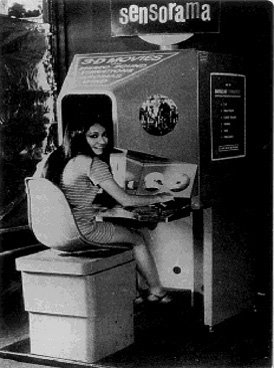
(image from http://www.unites.uqam.ca/AHWA/Meetings/2000.CIHA/Grau.html)
patent
for first HMD
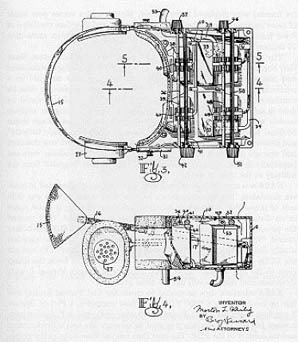
(image from http://accad.osu.edu/~waynec/history/lesson17.html)
1965 - Ivan Sutherland - University of Utah
1966 - Ivan Sutherland
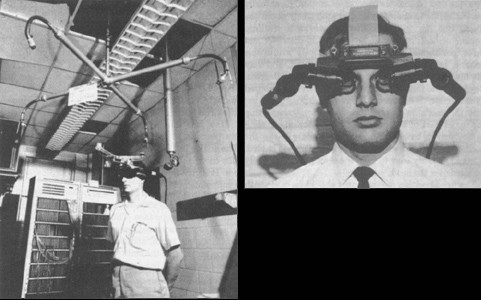
(image from http://accad.osu.edu/~waynec/history/tree/images/hmd.JPG)
1971 - Fred Brooks
1975 - Myron Krueger
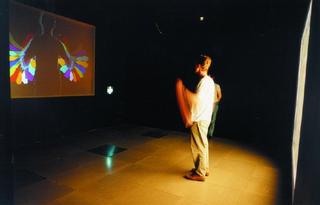

(image from http://resumbrae.com/ub/dms424/05/01.html)
1982 - Thomas Furness III
1984 - Michael McGreevy and friends
1985 - Jaron Lanier & VPL research
1986 - Ascension Technologies founded from former Polhemus employees
1989 - Autodesk
1989 - Fake Space Labs
1992 - Electronic Visualization Laboratory
1993 - GMD - German National Reseach Center for Information Technology
1993 - SensAble Technology
1993 - HITLab at University of Washington
1995 - Electronic Visualization Laboratory
1996 - Intersense founded
1998 - TAN / Royal Institute of Technology in Stockholm
1999 - reach in Technology
2000 - Electronic Visualization Laboratory
2001 - University of Tokyo
2003 - University of Arizona
2003 - Electronic Visualization Laboratory
Components of a VR System